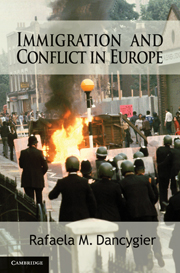Book contents
- Frontmatter
- Contents
- List of Figures and Tables
- Acknowledgments
- PART I GENERAL INTRODUCTION AND THEORETICAL FRAMEWORK
- PART II INTRODUCTION TO PART II
- PART III INTRODUCTION TO PART III
- PART IV INTRODUCTION TO PART IV
- 9 Conclusion
- Appendix A Coding Large-Scale Instances of Immigrant–Native and Immigrant–State Violence
- Appendix B Data and Variables: Immigrant Turnout
- References
- Index
- Titles in the series
PART III - INTRODUCTION TO PART III
Published online by Cambridge University Press: 17 November 2010
- Frontmatter
- Contents
- List of Figures and Tables
- Acknowledgments
- PART I GENERAL INTRODUCTION AND THEORETICAL FRAMEWORK
- PART II INTRODUCTION TO PART II
- PART III INTRODUCTION TO PART III
- PART IV INTRODUCTION TO PART IV
- 9 Conclusion
- Appendix A Coding Large-Scale Instances of Immigrant–Native and Immigrant–State Violence
- Appendix B Data and Variables: Immigrant Turnout
- References
- Index
- Titles in the series
Summary
Chapters 3 and 4 have demonstrated that immigrant conflict varies systematically across groups, place, and time. Immigrant groups that are influential local political actors are more likely to be greeted with violent anti-immigrant mobilization than groups that wield no such electoral clout. The latter, by contrast, have been shown to be involved in clashes with state actors. Both types of conflict have occurred more frequently where local economic resources are under pressure. These patterns are consistent with the main argument proposed in this book: Natives protest resource allocation to electorally pivotal immigrants, leading to immigrant–native conflict, while politically powerless immigrant minorities, who will not be able to induce local politicians to disburse scarce goods to them, will register their discontent with an unresponsive state, leading to immigrant–state conflict.
The evidence presented thus far corresponds to this logic, but some questions are still left unanswered. First, do groups that are residentially concentrated invite a xenophobic backlash? Given that local electoral clout tends to require geographic concentration (at least in the context of British council elections), correlations between immigrants' electoral power and immigrant–native conflict might in fact be due to residential patterns – though with these patterns' effects being mediated by economic conditions – rather than political muscle. Second, the investigations have thus far not explicitly addressed the timing of events. Is it indeed true that natives mobilize against immigrants who have attained political power, or is it instead the case that immigrants, once victimized, respond to native xenophobia by mobilizing politically?
- Type
- Chapter
- Information
- Immigration and Conflict in Europe , pp. 129 - 137Publisher: Cambridge University PressPrint publication year: 2010



